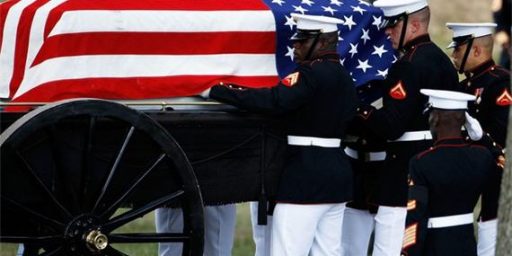Coffin Controversy
WaPo: Photos of Soldiers’ Coffins Revive Controversy
The Pentagon lost its tight control over the images of coffins returning from Iraq as about 350 such images were released under the Freedom of Information Act and a Seattle newspaper published a similar photo taken by a military contractor.
***
n March 2003, on the eve of war in Iraq, the Pentagon ordered an end to all media coverage of ceremonies for the returning remains of soldiers killed overseas. Although Dover already had such a policy, the Pentagon action enforced a military-wide ban on images of flag-draped caskets that dated to late 2000 but had not been followed.
With few exceptions, the ban had remained in force until recent days. But last week, about 350 photos from Dover were released under a Freedom of Information Act request by Russ Kick, a First Amendment advocate who runs a Web site called the Memory Hole (www.thememoryhole.org). Dover recommended that Kick’s request be denied, but officials at Air Mobility Command headquarters at Scott Air Force Base in Illinois authorized the release on appeal. After Kick posted the photos, they appeared on other Web sites, including the Drudge Report.
The sudden spread yesterday of the Dover photos of flag-draped caskets returning from Iraq came a day after Tami Silicio and her husband and co-worker, David Landry, were fired for the photo she took at Kuwait International Airport of caskets in an aircraft. The photo was published Sunday on the front page of the Seattle Times.
This is a strange story that’s been hanging around for months, although this turn of events has brought it to a head.
Kevin Drum is probably right on the political angle:
I don’t even support the war, but if anything these pictures might push me in that direction, not the opposite. It’s almost impossible not to be moved by these photos, and impossible not to recognize from them how much care is taken with the bodies and how seriously these deaths are taken.
The Bush administration’s political judgment is obvious: pictures of dead soldiers on the front pages of newspapers will turn people against the war. And maybe they’re right. But my guess is different: seeing these pictures would make most Americans feel pride in their country and determined that these lives not be lost in vain. On the other hand, hiding the pictures just makes it look like the administration is ashamed of its war.
I can’t disagree. The ostensible rationale for the policy was to protect the privacy of the grieving families, a sentiment I certainly understand. But we don’t apply that standard to any other tragedies, whether on the grand scale of the 9/11 attacks or the murders and fires that dominate local newscasts.
On the other hand, if the actual motivation for the policy is managing public sentiment about the war, then it’s not only likely ill-considered for the reasons Kevin gives but a violation of the spirit behind the 1st Amendment. Unlike Kevin, I support the war. But the idea that debate should flourish is at the core of the American political system. Joe Gandleman makes the point in PowerPoint fashion:
I think these photos should be allowed to be shown.
—The fact is statistics are not coming back to the United States to funeral homes. Banning the photos reeks of political manipulation, especially when the war is being fought by volunteer military forces and there is no draft to complicate political support.
—FACT: In wars people die.
—FACT: In wars there are funerals.
—FACT: A war — or even a national-interest circumstance which may require hostilities to continue despite public misgivings — isn’t ended simply because the reality of bodies coming back in boxes is acknowledged by the military. A policy is like a table with legs; if it’s strong enough it’ll stand, even if a leg is wobbly.
—FACT: If a policy or cause is so weak that it can be completely negated by photos of military coffins (or talk of a draft) then it lacks sufficient strength to be sustained if it suffers severe setbacks. Plus (a tiny point here) it is questionable in a democracy.
War is an awful thing. People die, are maimed, or left emotionally scared for life. While we shouldn’t fetishize the deaths of our soldiers and lose sight of the big picture, we certainly shouldn’t forget the sacrifices being made. And if the public thinks the price being paid for the objectives we’re after in Iraq is too high, that’s their call to make.





For once, I agree with Kevin. He makes valid points about the nature of the photographs. The last thing the White House needs to be seen as is ashamed of the war.
Kevin is right to a point.
The problem is that it might have a positive impact ONCE.
But if the media was allowed to, they would camp out at Dover, count the coffins, try to read the name tags and then call the parents of the kids to ask if they thought it was OK for Bush to be using the death of their son to support the war.
OR they would break into regular programming and show every time a single coffin hit.
OR they would start doing their own body count and wondering aloud if the Pentagon was not showing all the dead soldiers.
OR OR OR OR OR
Basically the media would do something completely stupid.
Anyone who can give me one instance of when they have not in the past is allowed to disagree. LOL
Or the photos would enter the public domain to be mutilated, exploited, or defaced by anti-war protestors. “Or, or, or, or” is right. I think if the White House organized decent deplaning ceremonies (like they did for MIA remains from Vietnam through the 80’s) then they would be accused of exploiting dead soldiers for political leverage. There just isn’t any win/win solution other than the one they have.
“Congress shall make no law respecting an establishment of religion, or prohibiting the free exercise thereof; or abridging the freedom of speech, or of the press; or the right of the people peaceably to assemble, and to petition the Government for a redress of grievances.”
That pretty much covers the or-or-or objections.
Oh James come now….
That does not even warrant a reply to someone with your education and background.
You know better than most how phenomenally weak that argument is.
Is HAL using your name?
Paul,
Your objections boil down to “the media might cover them unfavorably.” They do that all the time. They often–if not usually–distort the truth. So what? None of those objections are serious enough to trump the 1st Amendment.
The freedom of the press to publish does in no way guarantee the government will provide content.
James:
Of course the media has every right to publish whatever information we can get our grubby little mitts on. As a journalist, when I hear the government might be hiding something anywhere, I get just as twitchy and jumpy and righteous as any other journalist. But while an accurate report of the number of soldier deaths in the Iraq war is newsworthy, photos of flag-draped coffins aren’t. We all know what coffins look like, we all know what flags look like, and we are all aware of the fact that people are dying in Iraq.
Again, if the Bush administration laid out the red carpet for planes bringing back our war dead, saluted the coffins as they left the plane, and made sure each and every journalist that wanted to take pictures of the event could do so–they’d be accused of exploiting the occasion for political advantage. It’s damned if you do and damned if you don’t.